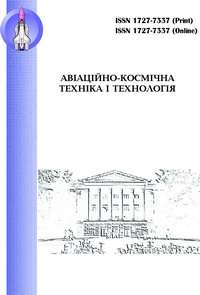Експериментальні дослідження геометричної точності зубчастих коліс за допомогою координатно-вимірювальної машини

View/
Date
2025Author
Сікульський, В.Т.
Майорова, К.В.
Заклінський, С.О.
Суслов, А.С.
Metadata
Show full item recordAbstract
Предметом вивчення в статті є апробація теоретичних та технічних рішень застосування координатно-вимірювальної машини (КВМ) шляхом контролю геометричних параметрів високоточних деталей типу зубчасте колесо. Метою статті є вивчення постійних похибок геометричної точності поверхонь та крайок зубчастого колеса контактним методом вимірювання. Завдання дослідження полягають у вимірюванні евольвенти, бокової лінії контакту і похибок кроку зубчастого колеса, биття зубчастого вінця, а також визначення впливу ексцентриситету на похибки кроку та биття на відповідність 7-му ступеню точності за ДСТУ ISO 1328-1:2006. Використовуваними методами є методи емпіричного дослідження – аналіз методів вимірювання, натурні експерименти та контроль. Отримані результати. Встановлено, що довжина загальної нормалі досліджуваного зубчастого колеса має критичну точність, що складає близько 99% від допуску на цей параметр. Тому для перевірки якості виготовлення поверхонь зубів евольвентних циліндричних коліс на практиці слід застосовувати саме контактний метод вимірювання, що характеризується наявністю безпосереднього дотику чутливого елементу (щупу) з поверхнею досліджуваного об’єкту, як той, що забезпечує високу точність (до 1,5 мкм), що в свою чергу мінімізує ризики відбраковування деталі. Висновки. За даними контролю встановлено, що на критичну постійну похибку впливає загальна накопичена похибка кроку зубів (55,3 % від допуску), а також радіальне биття робочих поверхонь (54,8 % від допуску). Зазначимо, що інші параметри мають запас точності у 20-30 %. Це пояснюється якістю дотримання технології виготовлення дослідного зубчастого колеса. Наступними дослідженнями можуть бути поопераційний контроль виготовлення зубчастого колеса з метою визначення критичних етапів технології, на яких довжина загальної нормалі шестерні набуває критично-допустимої точності. Також доцільним є створення методики сумісного використання 3D-сканування та контактного методу вимірювання з метою збільшення точності вимірювання, зменшенням кількості й часу вимірювань. The subject of study in this article is the approbation of theoretical and technical solutions for the use of coordinate-measuring machines (CMM) in the implementation of technical inspections of the parameters of high-precision gear-type parts. The purpose of the article is to study the systematic errors in the geometric accuracy of the gear wheel surfaces and edges by the contact measurement method using the chosen CMM. Methods of re-search are empirical – analysis of existing and widespread methods of measurement, full-scale experiments, and inspection. The research tasks are to measure the gear wheel involute (profile) and the lateral line (direction) of contact, pitch errors (separately) on the left and right sides of the gear teeth, gear ring runout, and to determine the influence of eccentricity on pitch and runout errors. Additionally, the study aims to check the studied gear wheel for compliance with the 7th degree of accuracy according to DSTU ISO 1328-1:2006. The methods used are: empirical and theoretical methods of measurement, comparison, and analysis. The results of the study presented in the arti-cle: indicate that the length of the studied gear common normal has a critical accuracy, which is about 99% of the tolerance for this parameter. Therefore in practice, to check the quality of manufacturing of the teeth surfaces of the involute cylindrical gears, it is necessary to use the contact measurement method, which involves the direct contact of the sensitive element (probe) with the surface of the examined object, as it provides accuracy up to 1,5m, which in turn, minimizes the risks of part rejection as spoilage. Conclusions: According to the technical inspection data, it was determined that the critical systematic error is affected by the total accumulated error of the tooth pitch, which is 55.3% of the tolerance, as well as the radial runout of the working surfaces, which is 54.8% of the tolerance. It should be noted that other parameters maintain a margin of accuracy of 20-30%. This can be attributed to the degree of compliance with the manufacturing technology of the experimental gear sample. The following research may involve post-operational inspection at each step of gear manufacturing in order to determine the critical stages of the technology where the length of the gear common normal acquires a critically acceptable accuracy. Furthermore, the subject of further research is the creation of a methodology for the combined use of optical 3D scanning and the contact measurement method in order to enhance measurement accuracy while reducing time and scope of measurements.
